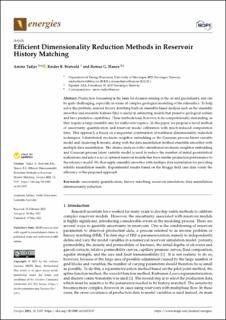| dc.contributor.author | Bratvold, Reidar Brumer | |
| dc.contributor.author | Hanea, Remus Gabriel | |
| dc.date.accessioned | 2021-10-25T13:35:11Z | |
| dc.date.available | 2021-10-25T13:35:11Z | |
| dc.date.created | 2021-10-21T18:16:23Z | |
| dc.date.issued | 2021-05 | |
| dc.identifier.citation | Tadjer, A., Bratvold, R.B., Hanea, R.G. (2021) Efficient Dimensionality Reduction Methods in Reservoir History Matching. Energies, 14(11), 3137 | en_US |
| dc.identifier.issn | 1996-1073 | |
| dc.identifier.uri | https://hdl.handle.net/11250/2825449 | |
| dc.description.abstract | Production forecasting is the basis for decision making in the oil and gas industry, and can be quite challenging, especially in terms of complex geological modeling of the subsurface. To help solve this problem, assisted history matching built on ensemble-based analysis such as the ensemble smoother and ensemble Kalman filter is useful in estimating models that preserve geological realism and have predictive capabilities. These methods tend, however, to be computationally demanding, as they require a large ensemble size for stable convergence. In this paper, we propose a novel method of uncertainty quantification and reservoir model calibration with much-reduced computation time. This approach is based on a sequential combination of nonlinear dimensionality reduction techniques: t-distributed stochastic neighbor embedding or the Gaussian process latent variable model and clustering K-means, along with the data assimilation method ensemble smoother with multiple data assimilation. The cluster analysis with t-distributed stochastic neighbor embedding and Gaussian process latent variable model is used to reduce the number of initial geostatistical realizations and select a set of optimal reservoir models that have similar production performance to the reference model. We then apply ensemble smoother with multiple data assimilation for providing reliable assimilation results. Experimental results based on the Brugge field case data verify the efficiency of the proposed approach. | en_US |
| dc.language.iso | eng | en_US |
| dc.publisher | MDPI | en_US |
| dc.rights | Navngivelse 4.0 Internasjonal | * |
| dc.rights.uri | http://creativecommons.org/licenses/by/4.0/deed.no | * |
| dc.subject | petroleumsteknologi | en_US |
| dc.subject | energi | en_US |
| dc.subject | olje- og gassnæringen | en_US |
| dc.subject | petroleumsgeologi | en_US |
| dc.title | Efficient Dimensionality Reduction Methods in Reservoir History Matching | en_US |
| dc.type | Peer reviewed | en_US |
| dc.type | Journal article | en_US |
| dc.description.version | publishedVersion | en_US |
| dc.rights.holder | © 2021 by the authors | en_US |
| dc.subject.nsi | VDP::Teknologi: 500::Berg‑ og petroleumsfag: 510::Petroleumsteknologi: 512 | en_US |
| dc.subject.nsi | VDP::Teknologi: 500::Berg‑ og petroleumsfag: 510::Geoteknikk: 513 | en_US |
| dc.source.volume | 14 | en_US |
| dc.source.journal | Energies | en_US |
| dc.source.issue | 11 | en_US |
| dc.identifier.doi | 10.3390/en14113137 | |
| dc.identifier.cristin | 1947656 | |
| dc.relation.project | Norges forskningsråd: 280473 | en_US |
| dc.source.articlenumber | 3137 | en_US |
| cristin.ispublished | true | |
| cristin.fulltext | original | |
| cristin.qualitycode | 1 | |

